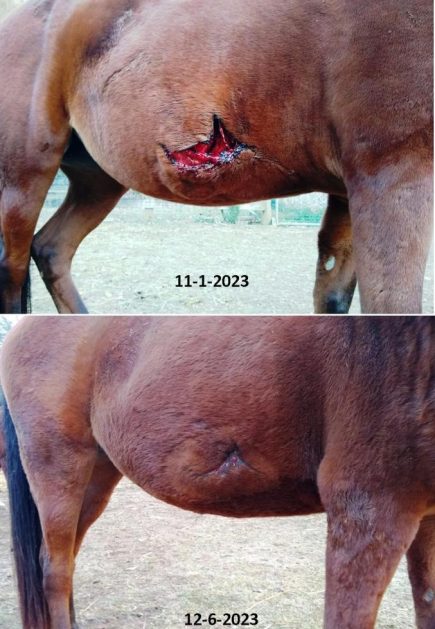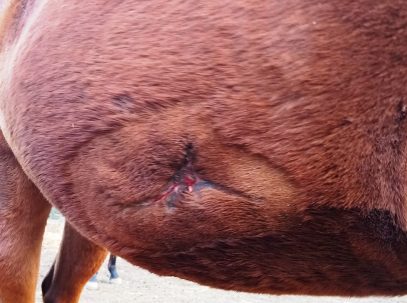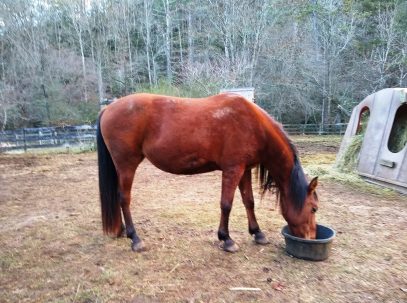Lucy - Traumatic Injury
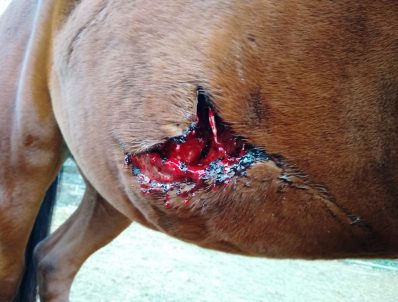
Discovered on the evening of 10/1/2023
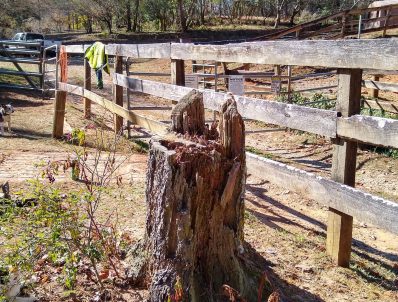
The source.
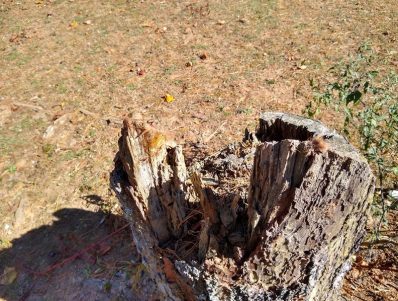
Rounded off and eroded peaks.
This wound was noticed when Lucy came up at feeding time, just before dark on Nov 1st 2023. Was I stunned? Shocked? You bet! Did I have a massive adrenaline rush? You bet! My mind was racing....I had to calm down and think.
Lucy was completely calm. I gave her and the two other mares (her sisters - Ethel and Star - all three rescued together) with her, their feeding as usual. Lucy was eating and drinking normally, walking around, acting like nothing had happened.
But WHAT HAPPENED??!
Lucy and her two sisters are in a small pasture with wood board fencing (no barbed wire, no any wire!) a quick look around while she ate revealed nothing.
It was getting dark...I didn't have my phone on me and needed to contact the vet.
While waiting for the vet to arrive I found where the injury occurred.
This stump has been there for many years. It is only 2 ft from the fence and about 3 ft high at the peaks. No average sized horse can fit through there.
It is highly visible, no obstructions in that pasture and she and her sisters have been in that pasture for over a year.
The pointed peaks, while they look sharp, they are not, having rounded from erosion over years.
And yet...there it was...blood, hair and hide.
Best guess? She was running around (she is prone to zoomies for no particular reason) and she miscalculated requiring her to try to jump it, or do a hard stop that caused her to rear up and come down on the stump. Then ripped herself off it.
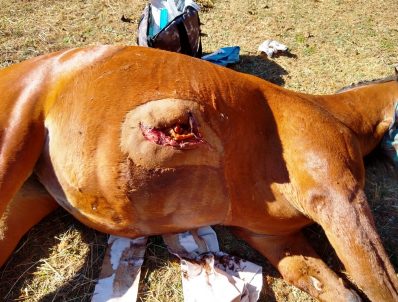
Wound packed with gauze while prepping for sutures.
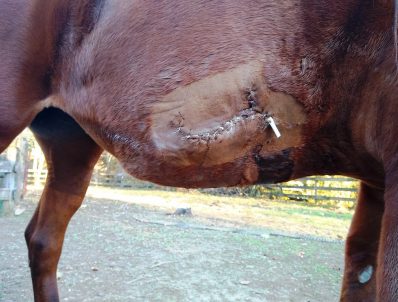
Stitched up and drain in place.
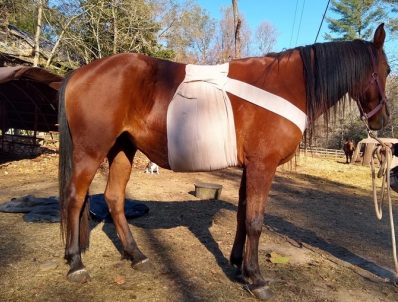
Bandage applied
We sedated her and laid her down. It was already obvious that the wound was full thickness, meaning all the way though the skin and down to the chest cavity wall...after closely examining the wound, the vet said that she came alarmingly close to punching through the chest wall. Had that happened, I wouldn't be making this web page...we would have had to put her down.
Unfortunately, she kept blowing through sedation and waking up too fast. The vet maxed her out on sedation (meaning if she got any more, the sedation would kill her) and she was STILL waking up and trying to get up. While the vet sutured, I held her head down. We put a rope on her font feet with a helper holding her legs so she couldn't bring her feet under her to get up.
Our vet put in five layers of sutures. A drain was put in, which is necessary for deep wounds like this because such wounds secrete serum for - on average - 10 days. That fluid must be able to escape the cavity or an abscess will result.
Even with all the sedation, and us holding her head and feet down, she jumped up before the external skin layer suturing was fully complete. That was finished with her standing.
It took about 2 hours to put her back together....over half of those hours holding her down (trying to!).
A body wrap dressing was applied to protect the area. Normally (in my experience) it takes about 30 minutes before a fully sedated horse - once standing, to be safe to let loose. If they are too groggy, they can stumble and cause more injury, or, even worse, try to eat and choke. This girl...? 10 minutes and she walked off like nothing had happened, joined her sisters and started eating hay.
She's a warrior. Warriors never quit. They are all "get over it, move on and git-r-done!" We figure that we should change her name to "Xena, Warrior Princess".
UPDATE 11/7/2023
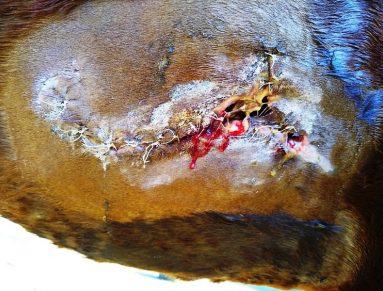
Skin mascerated by wound serum, pulling away from the sutures. Zinc oxide ointment or petroleum jelly, should be applied around the wound to protect the healthy skin.
There is a potential problem with a dressing applied over a draining wound. The wound serum has a purpose. It contains protein-eating enzymes that dissolve and remove damaged and dying tissue, essentially "cleaning" it out with the drainage. It's called "mascerating" or "melting" of the tissue. But it will also weaken the wound edges of it stays in contact with it too long.
Dressings need to be changed often, otherwise they fill up with serum and hold it on the area instead of letting it run/drip off of it.
Two major problems with this mare:
- She cannot be easily caught and doesn't like to be touched. She is distrustful of the intentions of humans and in this case, treating the wound hurts.
Why don't you put her in a stall you ask?? Well, that brings us to the second problem.
- If she is isolated from her sisters, she will tear herself (and the barn) apart trying to get to them. Even if they were in adjacent stalls, the claustrophobia of being locked in a box, stresses her way too much putting her at risk for developing gastric ulcers, or worse, colic.
That makes frequent dressing changes pretty much out of the question, especially when there is only one person (me) here at the time. Twice a day is the best we can do on any regular basis.
Oh there is a third major problem... We had to stop the body wrap, holding the dressing (and wound serum) pressed against her...and she started trying to pull it off. So we tried to leave the dressing off, but she almost immediately started licking it (not a big deal) and trying to bite and pull the drain out (big deal!). But we needed a way to cover her.
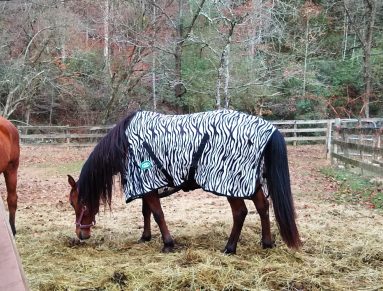
The weather warmed (it was very cold when this first happened) and flies are back out and at it.
We put on a fly sheet which helps thwart the flies somewhat and also helps keep dirt out if she lays down. I should say when she lays down...she lays down to sleep and rolls...like nothing happened!
To protect the wound, we attached a piece of plastic sheeting (heavy duty 6 mil, not food wrap) on the inside of the sheet over the wound area. We used small, strong magnets - one on the inside, one on the outside of the sheet connected together...about 9 such pairs and it held the plastic sheet perfectly.
This allows wound drainage to run off instead of soaking into the sheet, made it easy to wipe off every day, and it minimizes any irritation from the sheet rubbing on the wound.
UPDATE 11/10/2023
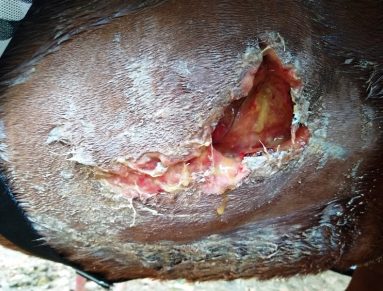
At this point, she has pulled off the dressing too many times and the sutures are failing because the skin is mascerating...a big hole has opened. The one positive is that the wound serum drainage has slowed way down.
Fortunately, there is no sight or smell of decaying flesh at this point but we will continue watching (and sniffing) it very carefully.
All we can do now is flush it out regularly as best we can (as she will allow) and hope and pray her body can heal it by secondary intention.
She has to wear the fly sheet as mentioned, but when it rains we have to switch to a waterproof rain sheet. A rain sheet is like a winter blanket but without the insulation. It's not cold enough yet for a blanket (it would over heat her).
Imagine, if you will, a horse that doesn't want to be caught or touched (and is so over having a painful wound messed with!) and you have to put on/take off big flappy coverings every time the weather changes, which requires touching her all over to get it all buckled up. If you have a schedule to keep, you can just get over it...it takes as long as it takes to just change her covering...so plan on being late!
UPDATE 11/13/2023
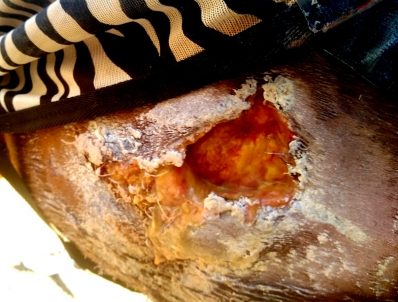
The wound is granulating in nicely! Still some drainage, but the stitches that tore loose are still there and likely acting as mini-drains.
One thing about wound drains ... if you leave them in longer than necessary...the wound will drain longer than necessary.
UPDATE 11/14/2023
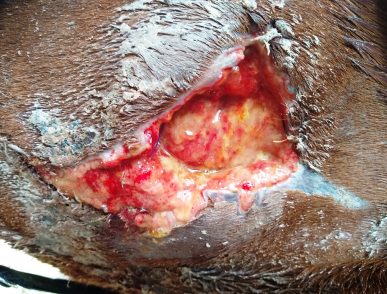
Stray sutures removed. Drainage has almost stopped. Granulation has accelerated...compare the depth of the wound on 11/13 to this one a day later. It's entirely possible we will have some proud flesh to deal with down the road...but that will be dealt with at the time. Having the cavity closing it is a huge plus!
UPDATE 11/17/2023
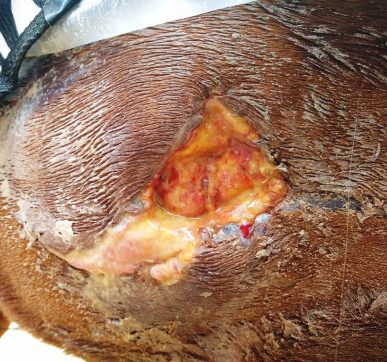
The wound opened on 11/10/2023 and seven days later there is a remarkable amount of healthy granulation tissue.
Daily wound care remains a challenge. Lucy still does not wish to be caught and is not happy about being touched generally, let alone on a big sore wound.
The protocol since the sutures busted open is to flush the wound, wipe any drainage off the healthy skin below then add ointment to protect that skin. We use a zinc based, comfrey infused salve that we make ourselves and have used for years with great success. We add certain essential oils that repel insects making this salve protective, healing and bug repelling. A word of caution when using comfrey products on wounds...do NOT use it on deep wounds that need to heal by secondary intention, and especially not on puncture wounds. Comfrey is a powerful healer and it will stimulate a wound to heal on the surface faster than it can granulate deep inside. That will leave a sealed pocket that very likely could abscess.
In Lucy's case, we are only using the salve up to the edges , not in the wound.
UPDATE 11/22/2023
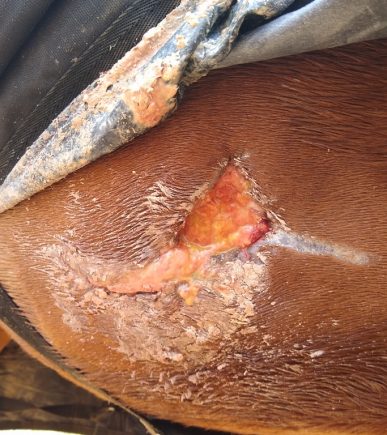
Even more beautifully healthy tissue filling in.
At this stage, the work of direct wound care is over. We check it daily. The salve is applied and any drainage (which is very minor at this point) is wiped off. The wound is irrigated/flushed with our "special sauce" solution.
She wears either a fly sheet or rain sheet all the time.
The plastic has been a God-sent idea! Without that we would have to wash the covering every day and put on a clean one which we were doing before we figured out the plastic trick....that's more work than treating the wound!
UPDATE 11/30/2023
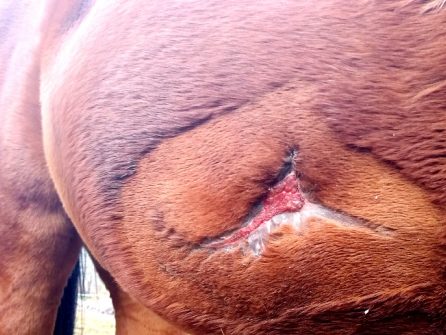
Wound healing over just 20 days from the wound rupture. Total of 30 days from the initial injury.
During this entire healing process, there has been no hint of infection, no necrosis, just rapid healthy tissue growth.-
Not only is this mare a warrior....it seems every cell in her body is too!
UPDATE 12/6/2023
36 days from the initial injury.
